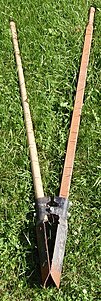Post hole digger: Difference between revisions
No edit summary Tags: Reverted Mobile edit Mobile web edit |
CodeTalker (talk | contribs) Reverted 3 edits by 98.4.216.190 (talk): Unsourced |
||
| Line 14: | Line 14: | ||
A '''post hole clam-shell digger''', also called '''post hole pincer''' or simply '''post hole digger''', is a tool consisting of two articulated [[shovel]]-like blades, forming an incomplete hollow cylinder about a foot long and a few inches wide, with two long handles that can put the blades in an "open" (parallel) position or a "closed" (convergent) position. |
A '''post hole clam-shell digger''', also called '''post hole pincer''' or simply '''post hole digger''', is a tool consisting of two articulated [[shovel]]-like blades, forming an incomplete hollow cylinder about a foot long and a few inches wide, with two long handles that can put the blades in an "open" (parallel) position or a "closed" (convergent) position. |
||
The tool is used to dig holes in the ground, typically from a few inches to a about a foot in diameter, for general purposes such as setting [[fence]] and [[signpost|sign]] posts or planting [[sapling]]s. In operation, the tool is jabbed into the ground with the blades in the open position. The handles are then operated to close the blades, thus grabbing the portion of [[soil]] between them. The tool is then pulled out and the soil is deposited by the side. The process is repeated until the hole is deep enough |
The tool is used to dig holes in the ground, typically from a few inches to a about a foot in diameter, for general purposes such as setting [[fence]] and [[signpost|sign]] posts or planting [[sapling]]s. In operation, the tool is jabbed into the ground with the blades in the open position. The handles are then operated to close the blades, thus grabbing the portion of [[soil]] between them. The tool is then pulled out and the soil is deposited by the side. The process is repeated until the hole is deep enough. |
||
"I wish my husband |
|||
Had a tool to dig more holes |
|||
In the cold cold ground." |
|||
==Comparison with earth augers== |
==Comparison with earth augers== |
||
Revision as of 17:44, 26 January 2022
A post hole clam-shell digger, also called post hole pincer or simply post hole digger, is a tool consisting of two articulated shovel-like blades, forming an incomplete hollow cylinder about a foot long and a few inches wide, with two long handles that can put the blades in an "open" (parallel) position or a "closed" (convergent) position.
The tool is used to dig holes in the ground, typically from a few inches to a about a foot in diameter, for general purposes such as setting fence and sign posts or planting saplings. In operation, the tool is jabbed into the ground with the blades in the open position. The handles are then operated to close the blades, thus grabbing the portion of soil between them. The tool is then pulled out and the soil is deposited by the side. The process is repeated until the hole is deep enough.
Comparison with earth augers
An earth auger is another tool that is used to dig holes in the ground, consisting of a rotating shaft with one or more blades attached at the lower end. A hand-powered auger is generally easier to use than a clam-shell digger, and can in principle dig deeper. It naturally creates a round and straight hole, but only of a fixed diameter. A clam-shell-type digger, in contrast, can be used to dig holes of any shape and any diameter greater than that of the open blades.[citation needed]
History and patent info
Clam-shell-type pole diggers seem to be a relatively recent invention, newer than earth augers. A patent was filed by J. Lawry of Lenior City, Tennessee in 1908.[1] The patent has the traditional clam-shell design with an extra spike in the center.[citation needed]
References
- ^ Jacob H. Lawry (1907) "Post-hole digger". US Patent , filed on 1907-06-11, granted on 1908-04-07, expired on 1925-04-07.
External links
![]() Media related to Post hole diggers at Wikimedia Commons
Media related to Post hole diggers at Wikimedia Commons


